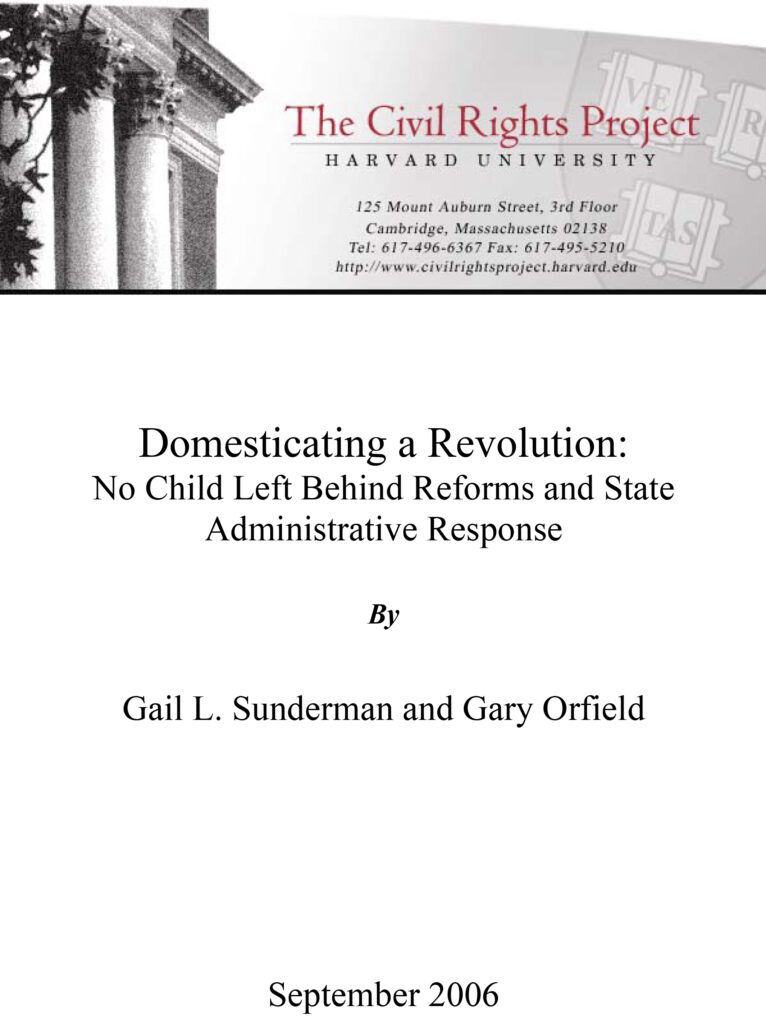Executive Summary
The No Child Left Behind Act of 2001 (NCLB) represents the most extraordinary expansion of federal power over public schools in American history but it relies not on the small federal bureaucracy but on state education agencies to play the crucial roles in implementing the federal mandates. Since state law sets the framework of educational requirements and policy and since states have sweeping authority over public schools and are traditionally central in the administration of many federal grant programs, this is not surprising. Because the requirements of the law are extraordinary, the new resources modest, and the requirements reach much further into the internal operation of schools than any previous federal intervention, the law provides a test of the capacity of state educational agencies to impose dramatic educational changes and administer sweeping sanctions reaching many schools and districts.
This report examines the role of state education agencies in implementing NCLB, their capacity and expertise to meet its requirements, and how this capacity varies across states, including how states are meeting the increased financial and human resource demands of NCLB and how they are working with schools and districts identified for improvement under the law. A fundamental question is whether or not the state agencies have the resources, knowledge, and organizational capacity to intervene on the scale demanded by NCLB. In addition, the report traces the development of the state role in education and how this shaped both the structure of the educational system and the functions that state educational agencies perform. This historical development has implications for the ability of state agencies to meet the NCLB requirements since it establishes the existing conditions that states operate under. The report uses a case study methodology and data collected from six states (Arizona, California, Georgia, Illinois, New York, and Virginia) that are part of an ongoing study of NCLB.
We found that state administrators did their best to implement that law and comply with the initial stages of enforcement, even when political battles over the law were raging around them. What the law confronted was not systemic resistance and sabotage, but rather conflicts between federal demands and local realities, with the state officials feeling pressures from both sides and trying to keep going.
- NCLB combines extremely demanding educational goals with extremely limited administrative resources. Additional federal resources were limited to the first year and while the law gave states modest funding for administration, it simultaneously imposed major new requirements that meant funds were shifted from one area to another.
- Federal resources for states to provide support to low-performing schools and districts was insufficient and did not represent additional money but rather a reallocation of Title I funds. The act authorizes a separate program for school improvement, but it has never received appropriations. The administrative set- aside for school improvement does not represent additional funds but rather a re- allocation of existing funds.
- State responsibilities under NCLB have increased far faster than either the size of state agencies or the expertise of the agency personnel. State education agencies faced staff reductions and budget cuts at the same time the federal government was demanding more of them under NCLB.
- States responded to the new NCLB requirements by giving staff more responsibilities and re-allocating funding and staff time to meet the new demands placed on them. Given the array of state responsibilities under NCLB, states focused on some of the requirements while ignoring or postponing others. Meeting the NCLB timelines (in order to avoid the loss of funds for being out of compliance), establishing a test-based accountability system, and developing data collection and reporting systems drove much of the state response to NCLB.State agencies focused on assessments, data, and the procedural parts of the law because this was where administrators had prior experience and were functions that state agencies could accomplish.
- State efforts to provide support for school improvement or to intervene directly in schools and districts prior to NCLB were limited at best and not very effective.
- The low level of federal investment in state school improvement under NCLB limited what states could do to help low-performing schools to compliance and monitoring activities. Because of limited federal and state resources, states put the burden for school improvement on districts, relied on regional centers to provide assistance to schools and districts, and made schools central to their own improvement through the school improvement planning process and school improvement plans.
This report shows striking good faith at the state administrative level to implement the NCLB requirements but also a striking lack of resources and knowledge to accomplish the extraordinary goals of NCLB. States focused on some of the requirements—data, assessments, and the procedural parts of the law—because these were areas where they had expertise and could actually control. For the most ambitious goals of improving school performance, the law provided few resources, and the previous experience of the states in dealing with much smaller numbers of schools and districts did not prepare them for the size and scope needed under NCLB. When NCLB comes up for re-authorization, the findings from this report would suggest that Congress needs to design a policy that recognizes both the realities of policy possibilities as known by educational professionals and the necessity in a federal system of leading by persuasion and incentives more often than by threats and negative sanctions.
In compliance with the UC Open Access Policy, this report has been made available on eScholarship:
